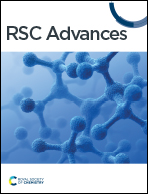Twistronics in two-dimensional transition metal dichalcogenide (TMD)-based van der Waals interface†
Abstract
Transition metal dichalcogenides (TMD) based heterostructures have gained significant attention lately because of their distinct physical properties and potential uses in electronics and optoelectronics. In the present work, the effects of twist on the structural, electronic, and optical properties (such as the static dielectric constant, refractive index, extinction coefficient, and absorption coefficient) of vertically stacked TMD heterostructures, namely MoSe2/WSe2, WS2/WSe2, MoSe2/WS2 and MoS2/WSe2, have been systematically studied and a thorough comparison is done among these heterostructures. In addition, the absence of negative frequency in the phonon dispersion curve and a low formation energy confirm the structural and thermodynamical stability of all the proposed TMD heterostructures. The calculations are performed using first-principles-based density functional theory (DFT) method. Beautiful Moiré patterns are formed due to the relative rotation of the layers as a consequence of the superposition of the periodic structures of the TMDs on each other. Twist engineering allows the modulation of bandgaps and a phase change from direct to indirect band gap semiconductors as well. The high optical absorption in the visible range of spectrum makes these twisted heterostructures very promising candidates in photovoltaic applications.



 Please wait while we load your content...
Please wait while we load your content...